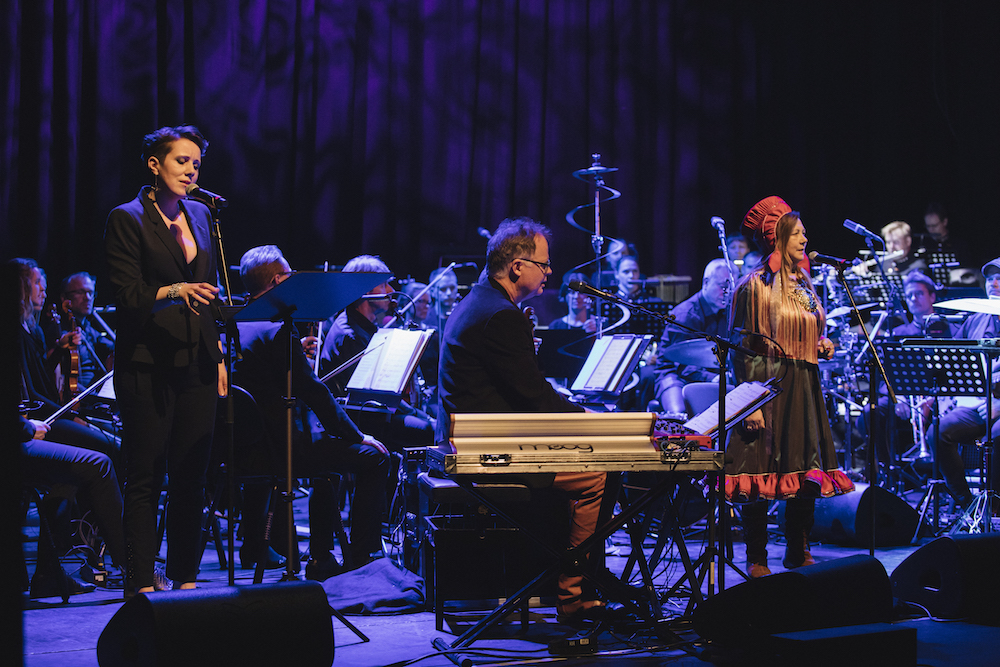For one Sámi musician, the joik is never the same
Frode Fjellheim’s Orchestral Joik Project is more than just traditional Sámi singing backed by symphonic sound.

(Marius Fiskum / Nordlysfestivalen)
Even if you have never heard of Frode Fjellheim, you’ve probably heard his music before. His song “Eatnemen Vuelie” was selected by Disney to be the opening song in the 2013 animated blockbuster Frozen.
Keep that song in mind as your read on (or go listen to it if you need to jog your memory). In the same way as that its vacillation between dreamy chants and thrusting, repetitive lyrics set the stage for the film that was to follow, it also provides a convenient introduction to Fjellheim’s latest effort — and not only because words come up short when trying to describe the sound of his Orchestral Joik Project which combines elements of traditional Sami song within the instruments of a contemporary symphony.
In some respects, the Orchestral Joik Project is not unique. Combining ‘modern’ music (in this case the orchestral part) with traditional (the joik part) has already proven a catchy combination for mainstream acts (think Paul Simon teaming up with Ladysmith Black Mambazo), as well as world and folk-music performers (Tuareg rock band Tinariwen is a good example of this).
[‘Igloo Art’ certification now in Inuit hands]
As something to be performed in an orchestral setting, the music of the Orchestral Joik Project falls in line behind its predecessors by offering symphonic arrangements of music typically not found in a classical orchestra’s standard repertoire of Bach, Beethoven, Brahms and the like. (For those of a certain age and into a certain type of music, symphonic versions of songs by Metallica, Yes, and the Beatles will spring to mind.)
Still, the Orchestral Joik Project stands out. Much of the appeal of hearing non-classical music arranged in a symphonic setting is the element of experiencing of a familiar melody in a new context. Fjellheim, however, neither turns the joik into a symphony, nor does a classical composition somehow turn into a joik. Instead he blends the contexts of all the forms of music the project encompasses (in addition to the two styles that make up its name, these include European opera, heavy-metal guitar and world music).
By design, the result is more discordant than the harmony of “Eatnemen Vuelie,” but it is no less evocative. Orchestral Joik performances conjure up a full register of images: danger, flight, silence, exhilaration, resolution.
Fjellheim, an admitted musical tinkerer known for combining joik with jazz, explains that the musical arrangements created for the Orchestral Joik Project’s four performances to date all seek to place the joik in the main role, making it, in effect, a part of the ensemble, not something that is supported by it.
“I’m adding something to the orchestra by picking out elements of joiking and using them as the foundation. Then I add something new to it. It’s similar to what I’ve done before, just in a new way,” he says.
[Can shared culture keep the Arctic a place of peace?]
Traditionally, joiking is a form of singing that seeks to describe a person or a place. Or as Niko Valkeapää, a Sámi musician from Finland explains, joiking is a form describing. “You do not joik about something, you simply joik something,” he says.
The Orchestral Joik Project, according to Fjellheim, is inspired by that tradition, even though the music of its performances normally breaks with tradition so he can explore what happens when you combine various types of music.
“This concert, and the musical parts it included, are not really traditional joiks,” he says.
Some of the elements of the piece do stay true to joiking’s original purpose. A piece titled “Tjåehkere,” Fjellheim explains, is based on an old joik that describes a sacred mountain and a stone used in the old Sámi religion.
“Here,” he says, “you can hear the melody in the joik describe the shape of the stone very clearly.”
In another part of the performance, a section titled “The Silent Voices,” he uses joiking to describe silence.
The most recent Orchestral Joik performance was on January 26, as the opening event of Nordlysfestivalen, a week-long music festival held in Tromsø, Norway, each year. Although Fjellheim’s own guttural, primal vocals were, as in the previous three performances, a key element, other elements were included at the suggestion of the other performers as a way to highlight their own experiences and strengths.
“That leaves the audience with a different experience each time,”Fjellheim says, noting that this reflects that the Orchestral Joik Project is not intended to be a single composition. “It’s more a framework for joik-related compositions I have arranged for orchestra.”
Although he admits that, as a professional musician, his aim with the project was partly “to give him more opportunities to play concerts,” he explains that it also makes it easier for orchestras to offer something different to their audiences: They get a package that includes the ingredients and the instructions for a performance, but leaves room for them to add their own accents.
“That allows it to evolve, to change. All the performances are orchestral, but how you experience them changes depending on who is involved.”
Which is why even if you’ve heard an Orchestral Joik Project peformance, you’ve probably never heard it before.
Editor’s note: Some expenses associated with reporting this story, including travel to Tromsø, were paid for by the Norwegian Foreign Ministry.